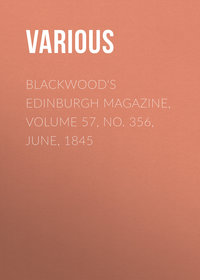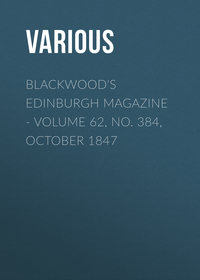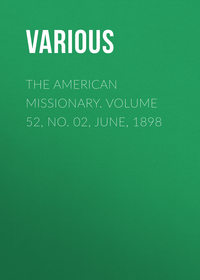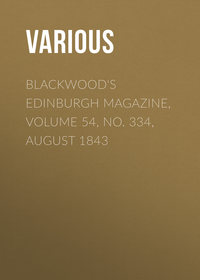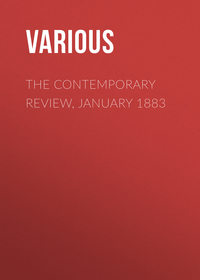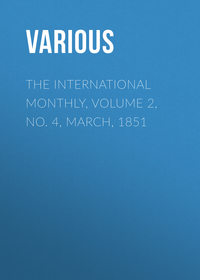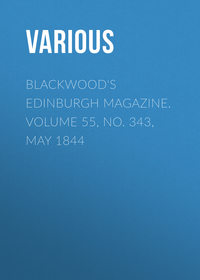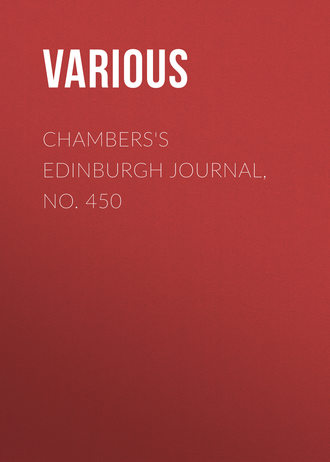 полная версия
полная версияChambers's Edinburgh Journal, No. 450
He proceeded in this strain: 'Was it not strange that Canning should subsist so long on so small a quantity of bread and water—four weeks, wanting only a few hours? Strange that she should husband her store so well as to have some of her bread left, according to her first account, till the Wednesday; according to the last, till the Friday before she made her escape; and that she should save some of her miraculous pitcher till the last day? Was the twenty-fourth part of a sixpenny loaf a day sufficient to satisfy her hunger? If not, why should she defer the immediate gratification of her appetite in order to make provision for a precarious, uncertain futurity? Shall we suppose some revelation from above in favour of one of the faithful? Perhaps an angel from heaven appeared to this mirror of modern virtue, and informed her, that if she eat more than one piece of bread a day, her small pittance would not last her till the time she was to make her escape. Her mother, we know, is a very enthusiastical woman—a consulter of conjurors, a dreamer of dreams; perhaps the daughter dreamed also what was to happen, and so, in obedience to her vision, would not eat when she was hungry, nor drink when she was thirsty. However that was, I would risk the event of the prosecution on this single circumstance, that, without the interposition of some preternatural cause, this conduct of the prisoner's must appear to exceed all bounds of human probability.'
Notwithstanding the conclusive exposure of her criminality, Elizabeth Canning was not entirely deserted by her partisans to the last. Two of the jury had difficulty in reconciling themselves to the verdict of guilty, suggesting that her story might be substantially correct, though undoubtedly she had made a mistake about the persons by whom she was injured. There was a technical imperfection in the verdict, and her friends strove to the utmost to take advantage of it. When it was overruled, and a verdict of guilty was recorded, she pleaded for mercy, saying that she was more unfortunate than wicked; that self-preservation had been her sole object; and that she did not wish to take the gipsy's life. The punishment to be inflicted on her was a matter of serious deliberation, as many of the common people were still so unconvinced of her wickedness, that an attempt to break the jail in which she was imprisoned might be feared, and as at that time the transportation system had not been established. It was not, however, unusual to send criminals, by their own consent, to the plantations, and the court gladly acceded to a desire by her relations, that she should be banished to New England.
THE ISLAND OF ISLAY
There is, perhaps, no country in Europe which possesses so great a variety of territory and social condition as our own. Between the plains of Cambridgeshire and the wilds of Sutherland—between the toiling, densely-packed multitudes of Lancashire and the idle, scattered cotters of the Hebrides, how vast a difference! The Land we Live in, as Charles Knight has called it, in a very delightful descriptive book, is a much more interesting study to its own people than is generally supposed; and we somewhat wonder that comparatively so few of our tourists go in search of what is picturesque, romantic, and novel within our own seas. These ideas arise in our mind in perusing a few pages of the new edition of the Guide to the Highlands and Islands of Scotland,2 by the Messrs Anderson of Inverness. In this book we have the benefit of remarkable fulness of knowledge on the part of the authors, and the accuracy of their statements is only rivalled by their judicious brevity. The account of some of the more out-of-the-way parts of the country brings before us not merely physical conditions highly peculiar, but, as it were, a totally peculiar set of historical associations. As an example, take a few swatches of the Island of Islay.
It is about thirty miles long by twenty-four in breadth, composed chiefly of elevated, but not Alpine ground, much of it moorish and bleak, but a great and constantly increasing space cultivated and sheltered. The finest island in the Hebrides, it belonged almost wholly to one proprietor, whose dignity of course was great. Within the last few years, he came to greet the Queen at Inverary, with a gallant following of men clothed in the Highland garb at his own expense. The island is now, however, in the hands of trustees, for the benefit of creditors, whose claims amount to upwards of L.700,000. There are lead-mines on the island, now unwrought, but from which it is understood silver had been derived, wherewith some of the family plate of the proprietor was formed. Whisky is distilled to such an amount, as to return L.30,000 per annum of revenue to the government. The Gaelic-speaking people, the fine shooting-grounds, the romantic cliffs and caves, the lonely moors and lochs of this island, altogether give it a degree of romantic interest calculated strongly to attract the regard of the intelligent stranger.
To pursue the narration of Messrs Anderson—'Islay is not a little interesting from the historical associations connected with the remains of antiquity which it presents, in the ruins of its old castles, forts, and chapels. It was a chief place of residence of the celebrated lords, or rather kings, of the Isles, and afterwards of a near and powerful branch of the family of the great Macdonald. The original seat of the Scottish monarchy was Cantyre, and the capital is supposed to have been in the immediate vicinity of the site of Campbelltown. In the ninth century, it was removed to Forteviot, near the east end of Strathearn, in Perthshire. Shortly afterwards, the Western Isles and coasts, which had then become more exposed to the hostile incursions of the Scandinavian Vikingr, were completely reduced under the sway of Harold Harfager, of Denmark. Harold established a viceroy in the Isle of Man. In the beginning of the twelfth century, Somerled, a powerful chieftain of Cantyre, married Effrica, a daughter of Olaus or Olave, the swarthy viceroy or king of Man, a descendant of Harold Harfager, and assumed the independent sovereignty of Cantyre; to which he added, by conquest, Argyle and Lorn, with several islands contiguous thereto and to Cantyre. Somerled was slain in 1164, in an engagement with Malcolm IV. in Renfrewshire. His possessions on the mainland, excepting Cantyre, were bestowed on his younger son Dugal, from whom sprung the Macdougals of Lorn, who are to this day lineally represented by the family of Dunolly; while the islands and Cantyre descended to Reginald, his elder son. For more than three centuries, Somerled's descendants held these possessions, at times as independent princes, and at others as tributaries of Norway, Scotland, and even of England. In the sixteenth century they continued still troublesome, but not so formidable to the royal authority. After the battle of the Largs in 1263, in which Haco of Norway was defeated, the pretensions of that kingdom were resigned to the Scottish monarchs, for payment of a subsidy of 100 merks. Angus Og, fifth in descent from Somerled, entertained Robert Bruce in his flight to Ireland in his castle of Dunaverty, near the Mull of Cantyre, and afterwards at Dunnavinhaig, in Isla, and fought under his banner at Bannockburn. Bruce conferred on the Macdonalds the distinction of holding the post of honour on the right in battle—the withholding of which at Culloden occasioned a degree of disaffection on their part, in that dying struggle of the Stuart dynasty. This Angus's son, John, called by the Dean of the Isles "the good John of Isla," had by Amy, great-granddaughter of Roderick, son of Reginald, king of Man, three sons—John, Ronald, and Godfrey; and by subsequent marriage with Margaret, daughter of Robert Stuart, afterwards Robert II. of Scotland, other three sons—Donald of the Isles, John Mor the Tainnister, and Alexander Carrach. It is subject of dispute whether the first family were lawful issue or illegitimate, or had merely been set aside, for they were not called to the chief succession, as a stipulation of the connection with the royal family, to whom the others were particularly obnoxious; or, as has been conjectured, from the relationship of the parents being thought too much within the forbidden degrees. The power of John seems to have been singularly great. By successive grants of Robert Bruce to his father, and of David II., Baliol, and Robert II., to himself, he appears to have been in possession or superior of almost the whole western coasts and islands....
'The inordinate power of these island princes was gradually broken down by the Scottish monarchs in the course of the fifteenth and early part of the sixteenth century. On the death of John, Lord of the Isles and Earl of Ross, grandson of Donald, Hugh of Sleat, John's nearest brother and his descendants became rightful representatives of the family, and so continue. Claim to the title of Lord of the Isles was made by Donald, great-grandson of Hugh of Sleat; but James V. refused to restore the title, deeming its suppression advisable for the peace of the country.'
At the close of the sixteenth century, when Bacon was writing his Essays, and Shakspeare his Hamlet, this remote part of the country was the scene of bloody feuds between semi-barbarous chieftains. A battle, with from one to two thousand men on each side, took place in Islay in 1598. The power of the Islay Macdonalds ultimately passed into the hands of the Campbells, who have since been the ascendant family in these insular regions.
'The remains of the strongholds of the Macdonalds in Islay are the following:—In Loch Finlagan, a lake about three miles in circumference, three miles from Port Askaig, and a mile off the road to Loch-in-Daal, on the right hand, on an islet, are the ruins of their principal castle or palace and chapel; and on an adjoining island the Macdonald council held their meetings. There are traces of a pier, and of the habitations of the guards on the shore. A large stone was, till no very distant period, to be seen, on which Macdonald stood, when crowned, by the Bishop of Argyle, King of the Isles. On an island, in a similar lake, Loch Guirm, to the west of Loch-in-Daal, are the remains of a strong square fort, with round corner towers; and towards the head of Loch-in-Daal, on the same side, are vestiges of another dwelling and pier.
'Where are thy pristine glories, Finlagan?The voice of mirth has ceased to ring thy walls,Where Celtic lords and their fair ladies sangTheir songs of joy in Great Macdonald's halls.And where true knights, the flower of chivalry,Oft met their chiefs in scenes of revelry—All, all are gone, and left thee to repose,Since a new race and measures new arose.'The Macdonalds had a body-guard of 500 men, of whose quarters there are marks still to be seen on the banks of the loch. For their personal services they had lands, the produce of which fed and clothed them. They were formed into two divisions. The first was called Ceatharnaich, and composed of the very tallest and strongest of the islanders. Of these, sixteen, called Buannachan, constantly attended their lord wheresoever he went, even in his rural walks; and one of them, denominated "Gille 'shiabadh dealt," headed the party. This piece of honourable distinction was conferred upon him on account of his feet being of such size and form as, in his progress, to cover the greatest extent of ground, and to shake the dew from the grass preparatory to its being trodden by his master. These Buannachan enjoyed certain privileges, which rendered them particularly obnoxious to their countrymen. The last gang of them was destroyed in the following manner by one Macphail in the Rinns:—Seeing Macdonald and his men coming, he set about splitting the trunk of a tree, in which he had partly succeeded by the time they had reached. He requested the visitors to lend a hand. So, eight on each side, they took hold of the partially severed splits; on doing which, Macphail removed the wedges which had kept open the slit, which now closed on their fingers, holding them hard and fast in the rustic man-trap. Macphail and his three sons equipped themselves from the armour of their captives, compelled them to eat a lusty dinner, and then beheaded them, leaving their master to return in safety. Macphail and his sons took shelter in Ireland. The other division of these 500 were called Gillean-glasa, and their post was within the outer walls of their fastnesses. These forts were so constructed that the Gillean-glasa might fight in the outer breach, whilst their lords, together with their guests, were enjoying themselves in security within the walls, and especially within the impenetrable fortifications of Finlagan.
'On Freuch Isle, in the Sound, are the ruins of Claig Castle—a square tower, defended by a deep ditch, which at once served as a prison and a protection to the passage. At Laggavoulin Bay, an inlet on the east coast, and on the opposite side to the village, on a large peninsular rock, stands part of the walls of a round substantial stone burgh or tower, protected on the land side by a thick earthen mound. It is called Dun Naomhaig, or Dunnivaig (such is Gaelic orthography.) There are ruins of several houses beyond the mound, separated from the main building by a strong wall. This may have been a Danish structure, subsequently used by the Macdonalds, and it was one of their strongest naval stations. There are remains of several such strongholds in the same quarter. The ruins of one are to be seen on an inland hill, Dun Borreraig, with walls twelve feet thick, and fifty-two feet in diameter inside, and having a stone seat two feet high round the area. As usual, there is a gallery in the midst of the wall. Another had occupied the summit of Dun Aidh, a large, high, and almost inaccessible rock near the Mull. Between Loch Guirm and Saneg, and south of Loch Gruinart, at Dun Bheolain (Vollan), there are a series of rocks, projecting one behind another into the sea, with precipitous seaward fronts, and defended on the land side by cross dikes; and in the neighbourhood numerous small pits in the earth, of a size to admit of a single person seated. These are covered by flat stones, which were concealed by sods.
'There are also several ruins of chapels and places of worship in Islay, as in many other islands. The names of fourteen founded by the Lords of the Isles might be enumerated. Indeed, most of the names, especially of parishes of the west coast, have some old ecclesiastical allusion. In the ancient burying-ground of Kildalton, a few miles south-west of the entrance of the Sound, are two large, but clumsily-sculptured stone-crosses. In this quarter, near the Bay of Knock, distinguished by a high sugar-loaf-shaped hill, are two large upright flagstones, called the two stones of Islay, reputed to mark the burying-place of Yula, a Danish princess, who gives the island its name. In the church-yard of Killarrow, near Bowmore, there was a prostrate column, rudely sculptured; and, among others, two grave-stones, one with the figure of a warrior, habited in a sort of tunic reaching to the knees, and a conical head-dress. His hand holds a sword, and by his side is a dirk. The decoration of the other is a large sword, surrounded by a wreath of leaves; and at one end the figures of three animals. This column has been removed from its resting-place, and set up in the centre of a battery erected near Islay House some years ago. Monumental stones, as well as cairns and barrows, occur elsewhere; and there is said to be a specimen of a circular mound, with successive terraces, resembling the tynewalds, or judgment-seats, of the Isle of Man, and almost unique in the Western Islands. Stone and brass hatchet-shaped weapons or celts, elf-shots or flint arrow-heads, and brass fibulæ, have been frequently dug up.'
THE APPLE OF THE DEAD SEA
We made a somewhat singular discovery when travelling among the mountains to the east of the Dead Sea, where the ruins of Ammon Jerash and Ajoloun well repay the labour and fatigue encountered in visiting them. It was a remarkably hot and sultry day. We were scrambling up the mountain through a thick jungle of bushes and low trees, which rises above the east shore of the Dead Sea, when I saw before me a fine plum-tree, loaded with fresh blooming plums. I cried out to my fellow-traveller: 'Now, then, who will arrive first at the plum-tree?' and as he caught a glimpse of so refreshing an object, we both pressed our horses into a gallop, to see which would get the first plum from the branches. We both arrived at the same moment; and, each snatching at a fine ripe plum, put it at once into our mouths, when, on biting it, instead of the cool, delicious juicy fruit which we expected, our mouths were filled with a dry bitter dust, and we sat under the tree upon our horses, sputtering, and hemming, and doing all we could to be relieved of the nauseous taste of this strange fruit. We then perceived, and to my great delight, that we had discovered the famous apple of the Dead Sea, the existence of which has been doubted and canvassed since the days of Strabo and Pliny, who first described it. Many travellers have given descriptions of other vegetable productions which bear analogy to the one described by Pliny; but, up to this time, no one had met with the thing itself, either upon the spot mentioned by the ancient authors or elsewhere.—Curzon's Visits to Monasteries in the Levant.
INVOCATION
Creator of the universal heartIn nature's bosom beating!Life of all forms, which are but as a partOf Thee, thy life repeating!Soul of the earth, thy sanctity impartWhere human souls are meeting!Bright as the first faint beam in mercy shewnUnto the barren-sighted,Where, on the yet unbroken darkness thrown,A sunny ray hath lighted,The glory of thy presence streameth downOn us, the world-benighted.To us the shadow of the earth is given,And ours the lower cloud;But though along its pathways tempest-driven,Our hearts shall not be bowed,While yet our eyes unto the stars of heavenWe lift, and pray aloud!Not with the prayers of long ago we pray,With red raised hand beseeching—Not with the war-voice of our elder clay,With the mammoth's bones now bleaching—Not for the mortal victories of a day,But—for the Spirit's teaching!Be Words of Light alone our javelins hurled,While Truth wings every dart:Oh, welcome, then, the legions of a world!—But ours no warrior's part;The ensigns we would bear are passions furled—Love, and a child's young heart!O.ART-EDUCATION OF CHILDREN
Let us here mention, that we have found the children of the sovereign of Great Britain at nine in the morning at the Museum of Practical Art; and on another occasion, at the same hour, amidst the Elgin marbles—not the only wise hint to the mothers of England to be found in the highest place. Accustom your children to find beauty in goodness, and goodness in beauty.—The Builder.
1
We have much pleasure in acknowledging one instance of a movement in the right direction, in connection with the Museum of Economic Geology in London. While nothing can exceed the beauty of the arrangements in that institution, for enabling everybody that chooses to study the science from the actual objects, the professors have, during the last winter, come forward with supererogatory zeal to teach the working-classes, and to illustrate in every possible way the bearings of the subject upon the arts and economy of life.
2
Edinburgh: Adam and Charles Black. Pp. 808.




